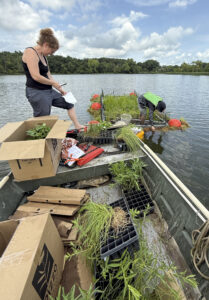What Giant ‘Secret Fresh Water’ Deposits Off US Coast Mean for Drinking Water – Newsweek

Report on the Discovery of Offshore Freshwater Aquifers and Implications for Sustainable Development Goals
A significant deposit of fresh water has been identified in a sub-seabed aquifer extending from New Jersey to Maine. This discovery by the research mission Expedition 501 highlights a potential alternative water source that could address critical challenges outlined in the United Nations Sustainable Development Goals (SDGs), particularly those related to water, health, and sustainable communities.
Discovery and Global Context: Advancing SDG 6
Expedition 501 Findings
Researchers from Expedition 501 confirmed the existence of a vast freshwater aquifer by drilling into the seafloor off the Atlantic coast. This finding substantiates long-held theories about offshore groundwater reserves and provides tangible evidence of their scale.
Contribution to SDG 6: Clean Water and Sanitation
The discovery directly addresses the objectives of SDG 6, which aims to ensure the availability and sustainable management of water and sanitation for all. With approximately a quarter of the global population lacking access to safe drinking water, offshore aquifers represent a vital, untapped resource.
- Global Lifeline: Experts suggest these hidden reserves could serve as a critical backup for regions facing water scarcity due to drought, climate change, or population growth.
- Resource for Coastal Communities: Offshore groundwater could provide a strategic reserve for coastal populations, enhancing their water security and resilience.
Implications for Public Health and Community Resilience
Addressing SDG 3: Good Health and Well-being
The potential purity of this sub-seabed water offers a promising solution to the growing problem of contaminated drinking water, a key target of SDG 3. Terrestrial water sources in the United States and globally are increasingly found to contain harmful pollutants.
- Pre-Industrial Origin: The water is believed to originate from a “pre-pollution” era, potentially making it free from modern, human-made contaminants such as PFAS chemicals, microplastics, and pharmaceuticals.
- Alternative to Contaminated Sources: As a cleaner alternative, this water could mitigate health risks associated with pollutants in current supplies, which have been linked to adverse birth outcomes and increased cancer incidence.
Supporting SDG 11: Sustainable Cities and Communities
By providing an alternative source of fresh water, the aquifer can enhance the sustainability and resilience of coastal communities, a core component of SDG 11. This is particularly relevant for densely populated coastal areas where traditional water resources are under severe strain.
Scientific Analysis and Viability
Geological Origins of Sub-Seabed Freshwater
Scientists have identified several mechanisms through which fresh water can be deposited and trapped in sub-seabed sediments. Ongoing research by Expedition 501 aims to determine the precise origin of this specific deposit.
- Lower Sea Levels: During past ice ages, when sea levels were lower, exposed continental shelves collected rainfall that was subsequently trapped by rising seas.
- Glacial Meltwater: Meltwater from glaciers that once covered the region could have infiltrated coastal sediments and become sealed under the ocean.
- Aquifer Extension: Terrestrial aquifers, the geologic formations that hold groundwater, naturally extend from the shoreline out beneath the sea.
Assessment of Potability
While samples are significantly less salty than seawater, the water is not immediately suitable for drinking and would require treatment. However, the necessary processes are less intensive than those for standard seawater desalination.
- Treatment Requirements: The water would likely need minor desalinization to reduce salt levels and treatment to remove dissolved minerals from surrounding rock formations.
- Reduced Contamination: Its age suggests it is free from industrial-era contaminants, making it a potentially safer raw water source compared to many surface and groundwater supplies.
Framework for Sustainable Management and Future Challenges
Governance and Accessibility Hurdles
The transition from discovery to a viable public water source faces significant logistical, economic, and governance challenges. Experts caution that tapping these resources may not be an immediate solution for current water issues.
- Economic Feasibility: The high cost of offshore extraction and treatment may be prohibitive compared to investing in the protection and conservation of existing freshwater resources.
- Regulatory Framework: Utilization would require a coordinated governance structure involving local, state, and federal authorities to manage extraction rights, distribution, and environmental oversight, aligning with the principles of SDG 17 (Partnerships for the Goals).
Environmental Considerations and Sustainability
Responsible management is critical to ensure that the extraction of offshore groundwater does not negatively impact marine ecosystems, a key concern of SDG 14 (Life Below Water). Furthermore, the rate of recharge must be studied to determine if the resource is finite or renewable.
Experts emphasize that while this discovery expands the portfolio of available water resources, the primary focus must remain on protecting existing clean water sources from pollution at its source.
Analysis of Sustainable Development Goals in the Article
1. Which SDGs are addressed or connected to the issues highlighted in the article?
-
SDG 6: Clean Water and Sanitation
- The article’s central theme is the discovery of a massive offshore freshwater aquifer. This directly relates to SDG 6, which aims to ensure the availability and sustainable management of water and sanitation for all. The text explicitly states that “around a quarter of the world’s population lacking access to safe drinking water” and discusses the new finding as a “potential and alternative source of freshened water.”
-
SDG 3: Good Health and Well-being
- The article establishes a clear link between water quality and human health, a core component of SDG 3. It highlights how current drinking water supplies are contaminated with pollutants that have severe health impacts, noting that “arsenic affecting birth outcomes” and communities exposed to “PFAS chemicals in drinking water have been found to have a 33 percent higher incidence of certain cancers.” The newly discovered “pre-pollution” era water is presented as a cleaner, healthier alternative.
-
SDG 14: Life Below Water
- The discovery and potential extraction of freshwater from beneath the seabed connect to SDG 14, which focuses on the conservation and sustainable use of oceans and marine resources. The article touches upon the environmental considerations of this process, acknowledging that a significant hurdle is “getting the water out of the ground, without harming the surrounding nature.” This highlights the need to balance resource utilization with the protection of marine ecosystems.
2. What specific targets under those SDGs can be identified based on the article’s content?
-
SDG 6: Clean Water and Sanitation
- Target 6.1: By 2030, achieve universal and equitable access to safe and affordable drinking water for all. The article addresses this by presenting the offshore aquifer as a potential “backup source for coastal communities” and a “lifeline in regions facing severe water scarcity,” directly contributing to the goal of providing safe drinking water.
- Target 6.3: By 2030, improve water quality by reducing pollution. The article discusses the contamination of current water sources with “PFAS chemicals,” “pesticides, herbicides, gasoline and numerous other chemical compounds.” The discovered water is significant because it originates from a “pre-pollution’ era,” potentially offering a source free from these “industrial age contaminants” and thus improving the quality of water available for consumption.
- Target 6.4: By 2030, substantially increase water-use efficiency and ensure sustainable withdrawals and supply of freshwater to address water scarcity. The article mentions that this discovery could serve communities “under stress from drought or population growth.” However, it also emphasizes the need for “responsible management… to avoid overuse” and studies on “appropriate pumping rates and volumes for use,” which aligns with ensuring sustainable withdrawals.
-
SDG 3: Good Health and Well-being
- Target 3.9: By 2030, substantially reduce the number of deaths and illnesses from hazardous chemicals and water pollution and contamination. The article directly supports this target by highlighting the health risks of current water supplies, such as higher cancer rates from PFAS. By proposing a source that is “likely much cleaner than many modern groundwater or surface water sources exposed to pollution,” it offers a direct pathway to reduce illnesses caused by contaminated drinking water.
-
SDG 14: Life Below Water
- Target 14.2: By 2020, sustainably manage and protect marine and coastal ecosystems to avoid significant adverse impacts. Although the target date has passed, its principle is relevant. The article’s mention of the challenge of extracting the water “without harming the surrounding nature” directly relates to the goal of protecting marine ecosystems during resource exploitation. The call for “responsible management” of these offshore reserves reinforces this connection.
3. Are there any indicators mentioned or implied in the article that can be used to measure progress towards the identified targets?
-
Indicators for SDG 6 Targets
- Implied Indicator for Target 6.1: The article’s statement that “around a quarter of the world’s population lacking access to safe drinking water” is a direct reference to the metric used for Indicator 6.1.1 (Proportion of population using safely managed drinking water services). The new aquifer could potentially improve this proportion for specific coastal regions.
- Mentioned/Implied Indicators for Target 6.3: The article mentions specific water quality parameters. It quantifies salinity, noting some samples are “as low as one part per thousand salinity.” It also qualitatively assesses water quality by discussing the presence or absence of specific pollutants like “PFAS chemicals,” “arsenic,” “pesticides,” “microplastics,” and “pharmaceuticals.” These are key measures related to Indicator 6.3.2 (Proportion of bodies of water with good ambient water quality).
-
Indicators for SDG 3 Target
- Implied Indicators for Target 3.9: The article provides qualitative health indicators by linking water contaminants to specific negative health outcomes. It states that PFAS exposure leads to a “33 percent higher incidence of certain cancers” and that arsenic is “affecting birth outcomes.” These health statistics serve as powerful, albeit informal, indicators of the mortality and morbidity rates associated with unsafe water, which is what Indicator 3.9.2 (Mortality rate attributed to unsafe water, unsafe sanitation and lack of hygiene) aims to measure.
4. Summary of SDGs, Targets, and Indicators
| SDGs | Targets | Indicators (Mentioned or Implied in the Article) |
|---|---|---|
| SDG 6: Clean Water and Sanitation |
6.1: Achieve universal and equitable access to safe and affordable drinking water.
6.3: Improve water quality by reducing pollution. 6.4: Ensure sustainable withdrawals and supply of freshwater to address water scarcity. |
For 6.1: The proportion of the global population lacking access to safe drinking water (“around a quarter of the world’s population”).
For 6.3: Measurement of water salinity (“as low as one part per thousand salinity”) and the presence/absence of contaminants like PFAS, arsenic, pesticides, and microplastics. For 6.4: The need for studies on “appropriate pumping rates and volumes” to ensure responsible management and avoid overuse. |
| SDG 3: Good Health and Well-being | 3.9: Substantially reduce deaths and illnesses from hazardous chemicals and water pollution. | For 3.9: Incidence of specific health issues linked to water contaminants, such as “a 33 percent higher incidence of certain cancers” from PFAS and negative “birth outcomes” from arsenic. |
| SDG 14: Life Below Water | 14.2: Sustainably manage and protect marine and coastal ecosystems. | For 14.2: The need for extraction methods that do not cause harm to “the surrounding nature,” implying a need for environmental impact assessments before exploitation. |
Source: newsweek.com

What is Your Reaction?
 Like
0
Like
0
 Dislike
0
Dislike
0
 Love
0
Love
0
 Funny
0
Funny
0
 Angry
0
Angry
0
 Sad
0
Sad
0
 Wow
0
Wow
0
















































:focal(1500,1000)/https://media.globalcitizen.org/a6/9a/a69a4720-d8a1-4715-b596-18738d03c05c/rotary_polio_hero_image.jpg?#)







/countries/sri-lanka/photo-credit---dmc-sri-lanka.tmb-1200v.jpg?sfvrsn=dc298bcc_1#)


















